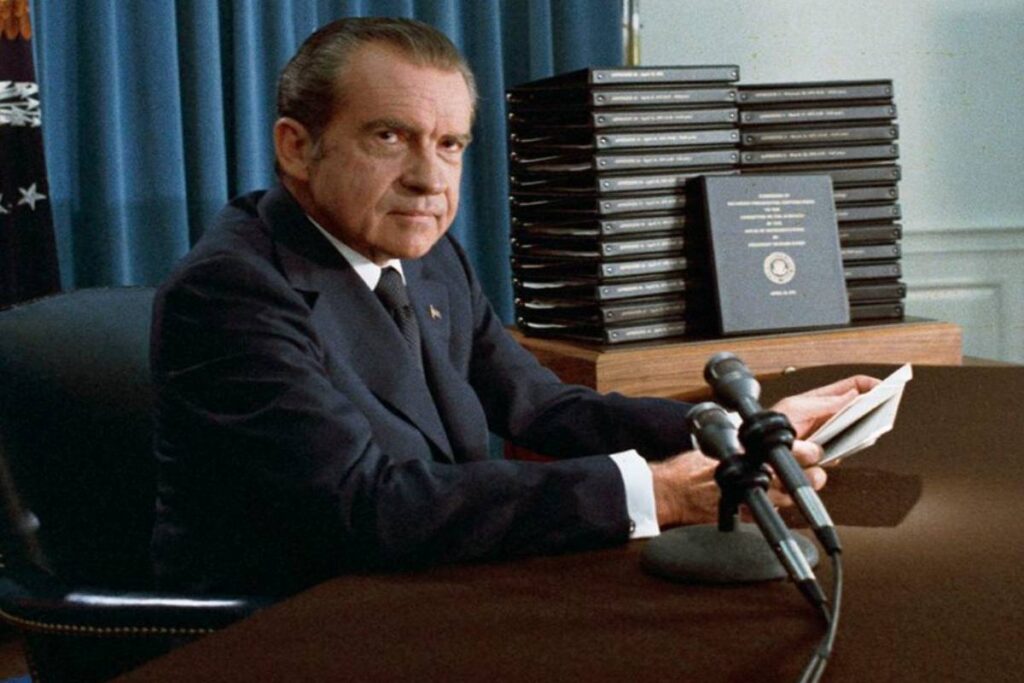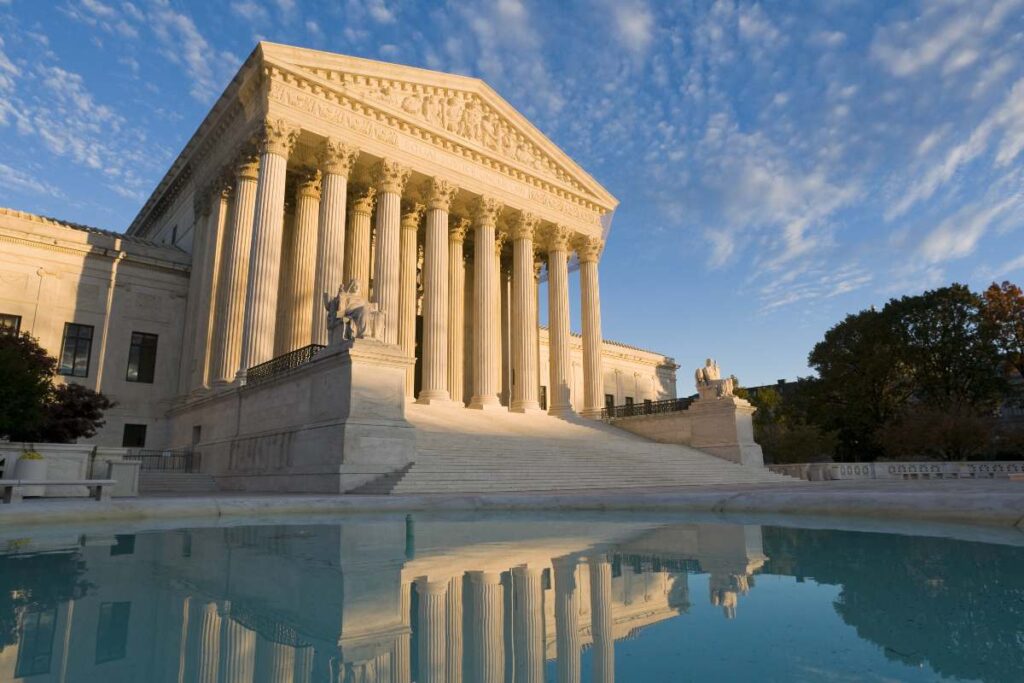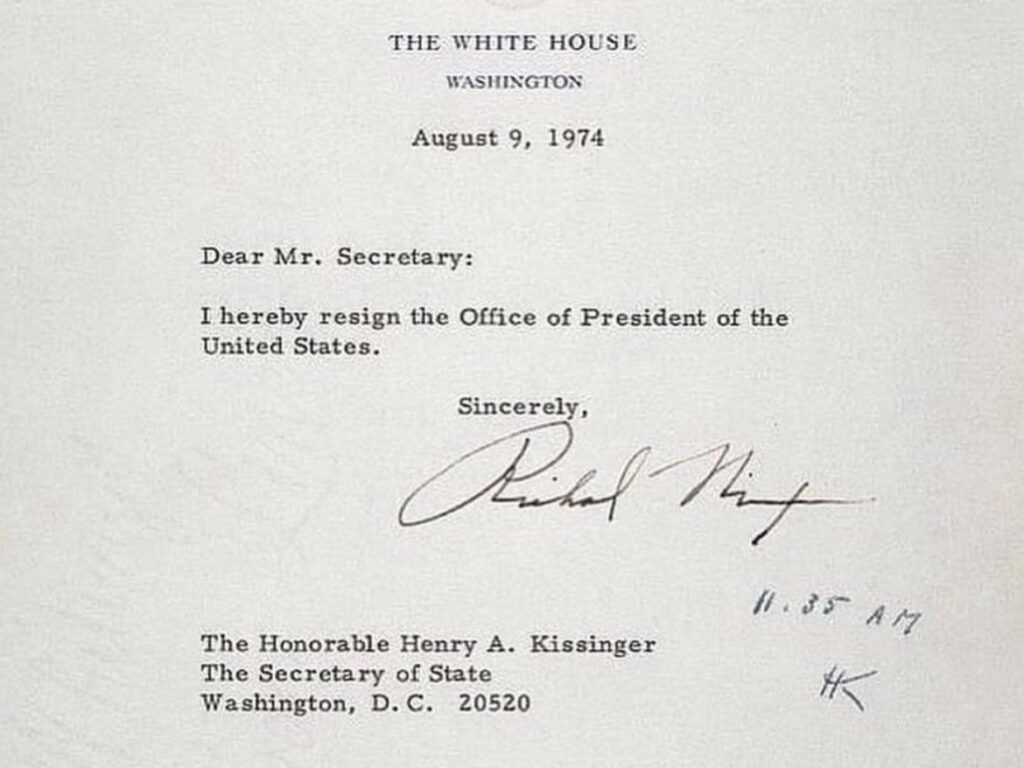After reading this, you might never trust the government again!
The Watergate Scandal remains fresh in the minds of millions of Americans. Many people still find it hard to believe it ever happened. It is regarded as one of the most embarrassing and shocking episodes in American presidential history.
Everything began in the early hours of June 17, 1972, after the vigilance of a security guard led to the arrest of 5 burglars at the Democratic National Convention headquarters.
What would have passed for a regular case of stealing soon began to unravel into a dark political spying attempt that flowed directly from the White House.
The Watergate Scandal is a series of shady White House business that started with a burglary and ended with the president’s resignation.
After about two years, despite the desperate cover-ups by President Richard Nixon’s administration, too many cans of worms had been opened. Public trust had been severely damaged.
The Watergate Scandal is a series of shady White House business that started with a burglary and ended with the president’s resignation. It shook the foundations of the American government so much so that the term “Watergate” became synonymous with corruption.
It is one of the darkest episodes in American politics. A stain in the White House that may never be erased.
But how did it happen, and why is it called the Watergate Scandal?
The Break-In: June 17, 1972
Frank Wills was one of the security guards at the Democratic National Convention (DNC) headquarters on June 17, 1972. As he patrolled the party’s space at the Watergate hotel and office complex, his eyes caught something curious.
One of the doors between the stairwell and the garage had masking tape on the door latch. He didn’t think too much of it at the time, said Willis in a 1974 interview with ABC News. So, he simply removed it and continued his patrol.

Things got a little more worrying after he found another tape on the same door latch after he returned moments later. “At that time, I became a little suspicious,” he said.
The plan was to install microphones and listening devices in the headquarters as well as take photos of sensitive documents in the building.
This time, he called the police.
Moments later, the cops arrested five strange men on the sixth floor of the building. They were burglars at the very least. It was one of them, James McCord, who placed the tape on the door. The others were Virgilio Gonzalez, Bernard Barker, Eugenio Martinez, and Frank Sturgis.
All four of McCord’s accomplices were Cuban Americans.
As it turned out, these men were more than burglars. They were spies on a mission. The plan was to install microphones and listening devices in the headquarters, as well as photograph sensitive documents within the building.
The police found communication and bugging devices, $2,300 in $100 bills, and keys to room 214.
An Unexpected Twist
It took days of work before curious reporters and investigators unravelled the motive of the five men. The men had links to the Nixon campaign. Precisely, the men had strong ties to the Committee to Re-elect the President—ironically nicknamed “CREEP.“
James McCord was identified as the head of security for the Nixon campaign. Two of the others had substantial relationships with the Central Intelligence Agency (CIA).
Soon, more questions began to emerge. What would the Nixon campaign staff and possible CIA assets want in the DNC? The discovery was even more baffling given that it was an election year. Many reporters sensed an opportunity and dug even deeper into the story.

Two of them, Bob Woodward and Carl Bernstein of the Washington Post, later struck gold. The Washington Post investigation found that the men were sent by the Nixon campaign to gather information on his political “enemies.”
The whole nation was taken aback. This was the beginning of one of the most damning political stories in US history.
Early Cover-Up Efforts
At this point, panic erupted in the Nixon camp. Their top-secret plan had just been exposed. If nothing is done, it could worsen. There were more worms in the can than they could allow the nation to see.
First, they silenced the burglars. They diverted campaign funds to the 5 men in exchange for their silence.
Additionally, top cabinet members and presidential aides utilized their influence to hinder the investigation. Their primary target was to blur any links to the president.
While these events were unfolding, President Nixon was working to dampen public interest in the case. He dismissed its seriousness and even referred to it as a “third-rate” occurrence.
Many of the presidential aides began to open up. They revealed the unhealthy state of the Nixon campaign and the many cover-ups involved in it.
Somewhere along the line, the president began to involve himself in plots to silence the truth. This scandal must not hinder his chances in the forthcoming presidential election.
Nixon’s Landslide Re-Election
By the time America cast its ballots for its next president, the truth was still hidden. Interestingly, Nixon won the election by a landslide.
The November 1972 presidential election was one of the easiest in American history. Nixon and his running mate, Spiro T. Agnew, clinched a massive victory in all 49 states.
They resoundingly defeated Democratic Party nominee George S. McGovern and his running mate Sargent Shriver by over 17 million votes. It turned out that Nixon didn’t need the burglary or bugging to win the election.

But Nixon and his campaign couldn’t celebrate fully. The Watergate Scandal continued to stare them in their faces. The problem refused to go away.
During the trial in 1973, things didn’t go as expected. Some of the accused pleaded guilty and began to talk.
Senate Hearings and the Special Prosecutor
The Watergate Scandal slowly began to gather steam. The Senate intervened in the matter by establishing a special committee to investigate it.
Sessions were televised and millions of Americans were glued to their screens as they watched committee chairperson from North Carolina, Senator Sam Ervin extract testimony after testimony from Nixon’s aides.
Many of the presidential aides began to open up. They revealed the unhealthy state of the Nixon campaign and the many cover-ups involved in it.
Away from the Senate, the Justice Department hired a special prosecutor, Archibald Cox, to investigate the matter. He was free from the influence of the White House and didn’t owe the president any loyalty.
His appointment was a massive threat to the president’s dirty secret. Soon, Cox began to get closer to the truth.
In July 1973, former White House aide Alexander Butterfield revealed that Nixon secretly recorded Oval Office discussions. This admission led investigators to demand the recordings from the president.
But Nixon refused.
The president didn’t stop there. He fought back.
The “Saturday Night Massacre“
President Nixon threw his first big punch at the investigation on October 20, 1973. In what is known as the “Saturday Night Massacre,” the president ordered his Attorney General, Elliot Richardson, to fire Cox.
In a shocking turn, Richardson decided to quit his position instead. The next in line, Deputy Attorney General William Ruckelshaus, did the same thing.
Nixon was desperate to stop Cox’s demands for the Oval Office tapes. Getting Cox sacked was his only way out.
He then turned to the Solicitor General Robert Bork, who stepped in as acting Attorney General. Bork yielded to the president’s wishes and fired Cox.

By this time, public outrage was at an all-time high. Richard Nixon’s approval ratings were dropping drastically. Also, calls for his impeachment were loud.
Supreme Court Intervention
The Supreme Court finally got involved in Watergate in 1974.
In a unanimous decision in the United States v. Nixon case, it ruled that the president couldn’t hide behind “executive privilege” to withhold the tapes.
At the same time, Congress had begun the impeachment process. Nixon and Bork had also bowed to pressure and hired a new Special Prosecutor, Leon Jaworski.
Jaworski continued from where Cox left off by demanding the tapes. The Supreme Court decision finally compelled Nixon to let go.
Watergate demonstrated that the American press was truly free. It showed that the judiciary wasn’t tied to the apron strings of the executive.
After a review, the recordings added insult to Nixon’s injury. They implicated the president pretty badly. One recording of a June 23, 1972, conversation showed the president telling his aides to use the CIA to block the FBI investigation.
This was all the proof they needed that Nixon was directly involved in the DNC bugging plan. It was all it took for the Nixon presidency to crumble.

Impeachment and Resignation
By late July of 1974, the House Judiciary Committee had approved three articles of impeachment. One for abuse of power, the second for contempt of Congress, and finally, obstruction of justice.
The odds were stacked against him. He even lost the support of his fellow party members in the legislature.
Nixon knew that he had reached the end of the road. The next month, he announced his resignation from office in an address to the nation.
In the August 8, 1974, speech, Nixon said, “I shall resign the Presidency effective at noon tomorrow. Vice President Ford will be sworn in as President at that hour in this office.”
Gerald Ford had only just been sworn in as Vice President following the resignation of his predecessor Spiro T. Agnew.
“I have never been a quitter. To leave office before my term is completed is abhorrent to every instinct in my body. But as President, I must put the interest of America first,” Nixon also said.
The next day, he tendered his resignation letter to Secretary of State Henry A. Kissinger.
The next month, Ford issued Nixon a presidential pardon. Ford argued that the controversial move was necessary for the nation’s healing.
So who went to jail for Watergate? G. Gordon Liddy, who helped hatch the spy plan, and James McCord, who refused to cooperate with authorities.
Both were convicted of several offenses and sentenced to prison.

Lessons of Watergate
The Watergate Scandal is more than a failed spy attempt. It was a test of the American Constitution and the principles of due process.
It was also a test for the entire American society.
From the discovery of the masking tape door to the Washington Post investigation, the Supreme Court decision, the impeachment by Congress, and the Nixon resignation, it demonstrated the strength of American systems.
Although it exposed many flaws, such as the concentration of power in one person, the Constitution allowed justice to prevail. Watergate demonstrated that the American press was truly free. It showed that the judiciary wasn’t tied to the apron strings of the executive.
The scandal also showcased the bravery of lawmakers and other government workers. Indeed, if we build strong institutions, even the most powerful individuals will be held accountable for their crimes.
The Watergate Scandal demonstrated that in America, no one is above the law.
Sources and Further Reading:
- Timeline of the Watergate Scandal → Washington Post (2022: “How the Watergate Scandal Broke to the World: A Visual Timeline”)
- The Failed Bugging Attempt → ABC News (2017: “The 1972 Watergate Burglary: How a Piece of Tape and an Astute Night Watchman Foiled the Political Crime of the Century.”)
- 1972 Presidential Election Numbers → The American Presidency Project
- President Nixon’s Resignation Speech→ National Archives (2024: “Nixon Resigns”)

